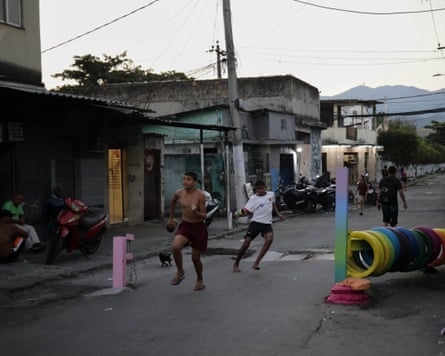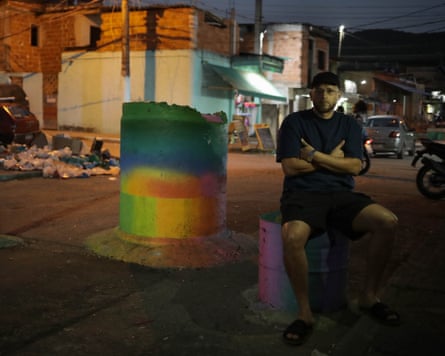Deep in a mosaic of redbrick favelas on the fringes of Rio, a weapons dealer, a drug smuggler and a crime lord held court on a corner as darkness enveloped the streets they rule.
An unnerving arsenal of assault rifles was on show as the trio fielded requests from customers, locals and staff, but the mood was relaxed.
The gunrunner sipped Coca-Cola and listened to Coldplay on one of his many mobile phones. A plasma television broadcast a Brazilian soap opera about the life of St Paul the Apostle. A gang accountant fingered wads of cash covering a plastic garden table below the screen, utterly unconcerned about being bothered by the police.
The group’s laid-backness was largely the result of the numerous barricades designed to stop security forces from reaching their sanctuary in the favela: metal and concrete fortifications built by local crime bosses to give them time to escape police raids.
“They’re there to put the brakes on the cops,” the gunrunner said of the obstacles, an increasingly familiar feature of Rio’s urban landscape as police and traffickers engage in a deadly arms race with no end in sight. Near where the gangsters sat, a 3.5-metre trench had been carved out of the road, making it impossible for cars to pass.
Barricades first appeared on the roads leading into Rio’s favelas in the 1980s, as cocaine and automatic rifles began flooding such working-class areas and drug lords sought to obstruct police incursions into their turf. Back then, they were made up of supersized speed bumps designed to smash the suspension of any vehicle that tried to cross them at speed. Sometimes, traffickers placed nail-filled potatoes on the humps to puncture police tyres.
Forty years later, the barriers have taken on a far more sophisticated and warlike dimension: huge, permanent roadblocks fashioned from steel rails, drainage pipes, boulders, tree trunks, concrete-filled barrels and heaps of tyres. In some places, entire walls have been built to stop bulletproof police vehicles advancing along strategic roads. Burning buses are sometimes used.
“They look like medieval structures people used to defend their fortresses … They are works of civil engineering,” said Lt Claudia Moraes, a spokesperson for Rio’s military police force, whose raids the barricades were created to disrupt.
Lt Moraes said the guerrilla tactics were “an affront to the state and society as a whole” and that officers conducted weekly operations to tear down the barricades, which made life a misery for favela residents. Since January, police had destroyed barricades in more than 2,500 different locations, removing 28,155 tonnes of rubble – the equivalent to the weight of 44 of Rio’s Christ the Redeemer statue or 125 Statues of Liberty.
Barricades have become such a serious problem that in 2020, Rio’s government set up an anti-blockade unit called the Special Operations Support Centre (NAOE). “In truth it’s a demolition squad,” Lt Moraes said of the group, which uses backhoes fitted with hydraulic hammers to smash barricades so police vehicles can access the favelas.
The unit’s 41 operatives hone their skills in a replica shantytown called “the Citadel”, built on a military base sandwiched between Rio’s international airport and one of its largest favelas.
One recent morning, nine of the group’s members stormed the scenographic shantytown, assault rifles raised, as a black backhoe loader smashed a battered Fiat Palio out of its path. Twenty metres ahead, sparks flew as an officer used a blowtorch to cut a 5ft rail jutting out of the ground before a giant steel gate.
The unit’s leader, police veteran Lt Luiz Felipe Medeiros, said real-life operations lasted up to eight hours and were essential to “re-establish the constitutional right to come and go” in gang-run favelas where ambulances, fire crews and bin collectors could not operate. During one mission, in a sprawl of favelas called the Complexo do Alemão, 20 tonnes of debris were removed after operatives destroyed barriers and pillboxes used to shoot at police.
But Rio’s traffickers have machinery too, and special barricade-building teams, meaning barriers are often rebuilt within hours of being dismantled.
Favela-born artist Tainan Cabral grew up watching barricades proliferate on the streets around his home.
He saw the defensive positions as a symbol of state neglect, highlighting how successive governments had ceded control of chunks of the city to criminal groups. But Cabral also saw a creative opportunity in the illegal structures and, six years ago, started painting them to turn “something bellicose into something artistic” and bring a touch of joy to the favelas’ often violent routine.
“Barricades transmit a climate of war … I try to turn them into sculptural monuments … I started to see this place as a sculpture park,” the 34-year-old artist said during a stroll through some of the barricaded streets he has beautified.
Cabral uses bright, psychedelic colours he believes contrast “with the raw reality” of the favela. “Cheerful tones that convey peace, tranquillity and freshness … because the barricades are bad enough on their own.”
Gunfights meant Cabral’s frontline artworks were frequently damaged or destroyed, meaning the artist constantly returned to them to make changes or repairs. “It’s an ephemeral open-air art gallery that dies and is reborn,” he said. “And I revisit the barricades because I want to keep this sculpture park alive.”
If Rio’s conflict ever ended, the artist planned to turn the barricades into “postwar” memorials – but Cabral doubted that day would come. “It’s my dream … to see more peace. But for it to really end?” The artist shook his head.











